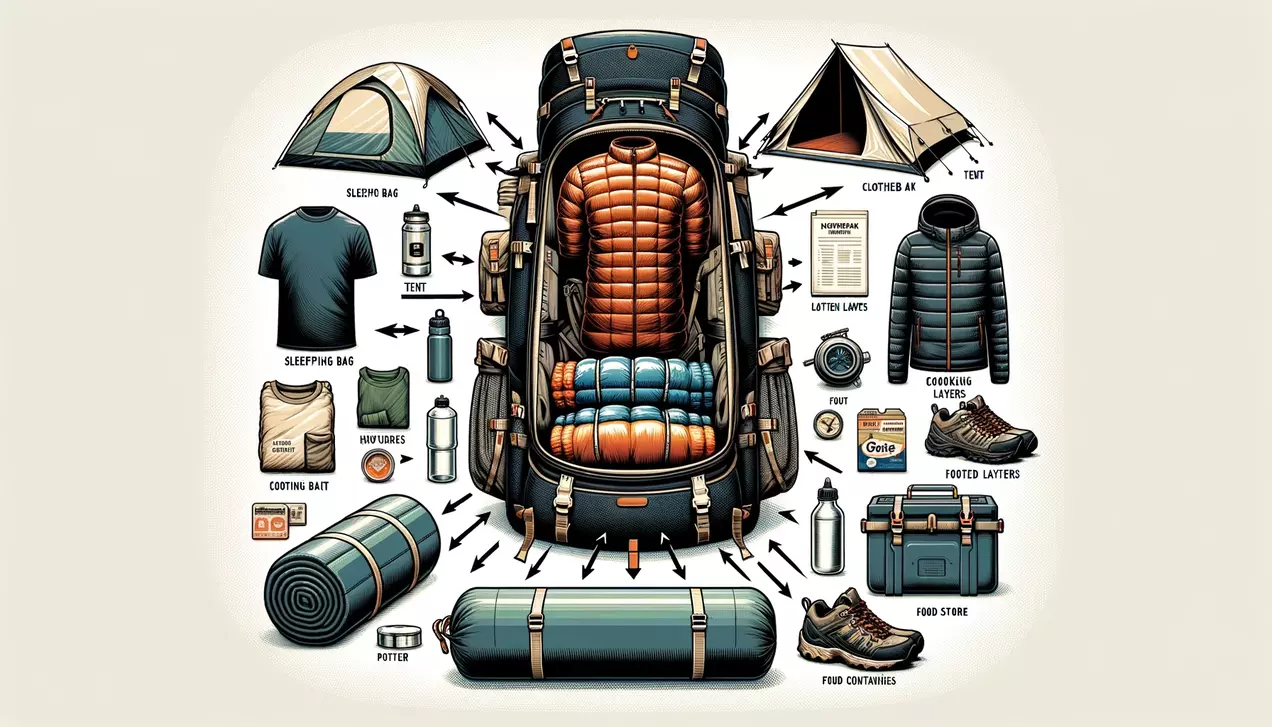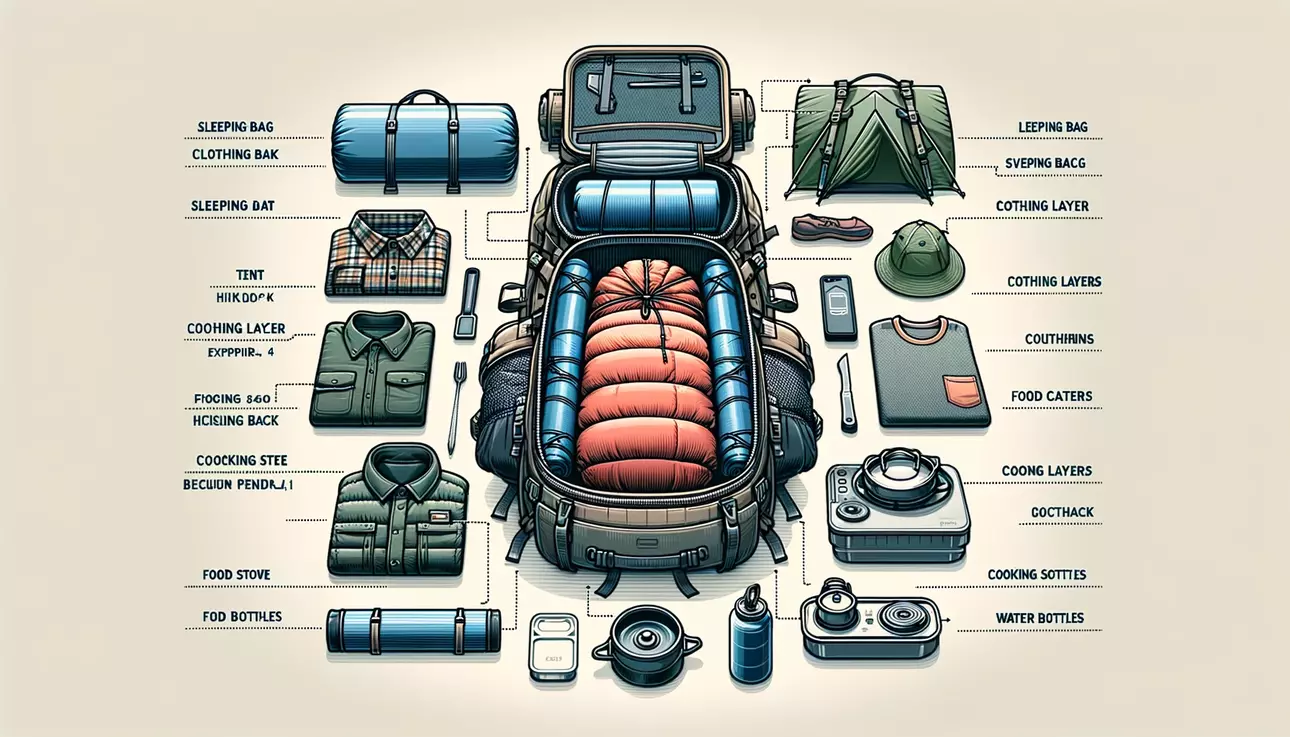How to Pack a Hiking Backpack: A Comprehensive Guide
Are you gearing up for an exciting hiking adventure? Packing your backpack efficiently is crucial for a comfortable and enjoyable journey on the trail. In this guide on how to pack a hiking backpack diagram, we’ll walk you through each step, ensuring you have everything you need for a successful hike. Let’s dive in!

Choosing the Right Backpack
Before you start packing, selecting the right backpack for your hiking trip is essential. Here’s what you need to consider:
Size Matters
When choosing a backpack, consider the duration and type of hike you’ll embark on. Opt for a more giant backpack for longer trips that can accommodate all your gear and supplies. Shorter day hikes may require a smaller, more compact backpack.
Features to Look For
Look for backpacks with multiple compartments to help you organize your gear effectively. Additionally, consider features such as hydration system compatibility, padded shoulder straps, and waist belts for added comfort during long treks.
Weight Distribution
Proper weight distribution is critical to preventing strain and discomfort during your hike. Ensure the backpack evenly distributes the weight across your shoulders and hips to minimize fatigue.
Organizing Your Gear
Now that you have the right backpack, organizing your gear before packing is time. Here’s how to do it:
Categorize Your Gear
Separate your gear into essentials (first aid kit, navigation tools), clothing, food, and personal items. This will make it easier to pack and locate items when needed.
Packing Zones
Divide your backpack into packing zones, including the bottom, middle, top, and external pockets. This division ensures that heavy items are placed closer to your back for better balance and stability.
Use a Packing Diagram
Consider using a packing diagram to visualize the ideal packing order. A diagram can help you understand the placement of items within the backpack, making packing more efficient.

Packing Essentials
Now, let’s delve into the specifics of packing your backpack. Here’s how to pack each section:
Bottom of the Backpack
Pack your sleeping bag and other heavy items at the bottom of your backpack. This will provide a stable base for the rest of your gear.
Middle Section
In the middle section, place your clothing and other heavier items to help maintain balance and stability while hiking.
Top Section
Pack lightweight essentials and items you may need frequently at the top of your backpack for easy access during the hike.
External Pockets
External pockets can be used to store snacks, maps, a first aid kit, and other items you may need to reach quickly without unpacking the entire backpack.
Step-by-Step Packing Guide
Whether you’re a seasoned hiker or a beginner, here’s a detailed packing guide to ensure you’re prepared for your adventure:
How to Pack a Hiking Backpack for a Week-Long Trip
For longer trips, carefully pack your essentials, clothing, and food, ensuring the weight is evenly distributed for comfortable trekking.
Best Way to Pack a Hiking Backpack for Beginners
If you’re new to hiking, focus on packing the essentials and lightweight items to avoid overburdening yourself. Could you keep it simple and manageable?
Efficiently Packing a Hiking Backpack with a Diagram
Visualize the packing process using a detailed diagram, ensuring that each step is straightforward and easy to follow.
Tips and Tricks
Here are some additional tips to enhance your packing experience and overall hiking adventure:
Lightweight Hiking Backpack Packing Tips
Consider lightweight alternatives for your gear to reduce overall pack weight without compromising on essential items.
How to Distribute Weight in a Hiking Backpack
Balance the load in your backpack to ensure maximum comfort and stability while trekking through various terrains.
Packing a Hiking Backpack for Different Terrains
Understand how packing may vary based on the terrain you’ll be hiking- mountains, forests, or deserts. Each environment may require specific gear and supplies.
Common Mistakes to Avoid
It’s essential to be aware of common packing mistakes to ensure a smooth hiking experience:
Overpacking
Avoid the temptation to pack unnecessary items. Overpacking can lead to a heavier load and excessive strain on your body.
Poor Weight Distribution
Improper weight distribution can lead to discomfort and fatigue. Be mindful of how you distribute the weight in your backpack.
Ignoring Accessibility
Keep frequently used items easily accessible. Ignoring accessibility can lead to frustration when locating essential items on the trail.
Final Checklist
Before you hit the trail, run through this final checklist to ensure you’re fully prepared for your hike:
Pre-Hike Checklist
Double-check your gear, supplies, and essentials to ensure nothing is forgotten before you embark on your adventure.
Test Run
Consider doing a test pack and a short hike to adjust your backpack for maximum comfort and functionality.
Conclusion
As you prepare for your hiking expedition, remember that proper packing is essential for a successful and enjoyable trip. By following the guidelines in this comprehensive guide, you’ll be well-equipped to tackle the trails confidently. We hope you found this guide helpful in preparing for your next adventure. Please share your packing tips and experiences in the comments, and don’t forget to check out our related posts for more hiking insights. Happy hiking!
Gear Selection: Choosing the Right Equipment
Equipping yourself with the right gear is essential for a successful and enjoyable hiking experience. Each item, from the backpack to the various accessories and apparel, plays a crucial role in ensuring your comfort and safety on the trail. Let’s explore some key considerations when selecting your hiking gear.
Backpack Fit and Comfort
While the size and features of your backpack are essential, the fit and comfort are equally crucial. Ensure that the backpack fits snugly on your back, with the shoulder straps and hip belt properly adjusted to distribute the weight evenly. Try on different models and adjust the straps until you find the most comfortable and stable, even when fully loaded.
Footwear: The Foundation of Your Hike
Choosing the proper hiking boots or shoes is one of your most important decisions. Opt for well-cushioned, durable footwear with good traction to support and prevent blisters. Consider the terrain you’ll be hiking on and choose a pair that offers the appropriate level of ankle support and water resistance.
Layering for Versatility
Dressing in layers is necessary for hiking, as the weather and temperature can change quickly on the trail. Pack a base layer to wick away moisture, an insulating mid-layer for warmth, and a waterproof outer shell to protect you from the elements. This layering system allows you to adjust your clothing to maintain comfort throughout your hike.
Outdoor Apparel and Accessories
In addition to your base layers, consider packing items like quick-drying hiking pants, moisture-wicking socks, and a sun hat to protect you from the elements. Don’t forget to pack a headlamp or flashlight, a multi-tool, and any other specialized gear you might need for your specific hike.
Navigation and Safety Essentials
Navigating the trail and ensuring your safety should be top priorities when planning a hiking trip. Here are some essential items to pack:
Navigation Tools
Bring a map of the area, a compass, and a GPS device (or a smartphone with a GPS app) to help you stay on track and find your way, even in the event of poor visibility or signal loss.
Emergency Preparedness
Pack a well-stocked first aid kit, emergency blankets, and fire-starting supplies in case of unexpected situations. Carry a portable power bank to keep your devices charged.
Communication and Safety Signaling
Bring a whistle, a signaling mirror, and a satellite communication device (if available) to help you signal for help in an emergency. Additionally, inform someone of your hiking plans and check in with them regularly.
Sustenance and Hydration
Staying nourished and hydrated is crucial for maintaining energy and endurance on the trail. Here’s how to pack for your hiking sustenance:
Food and Snacks
Pack a variety of high-calorie, nutrient-dense foods and snacks to keep your energy levels up. Consider non-perishable options like trail mix, energy bars, and dehydrated meals. Pack utensils, a lightweight stove, and fuel if you plan to cook.
Hydration Systems
Bring a sturdy water bottle or a hydration pack with a built-in reservoir to ensure easy access to water throughout your hike. If hiking in areas without reliable water sources, consider packing a water filter or purifier to provide safe drinking water.
Electrolyte Replenishment
Don’t forget to pack electrolyte-rich drinks or tablets to help replace the minerals you’ll lose through sweat during your hike. Staying adequately hydrated and replenishing electrolytes can help prevent fatigue and muscle cramps.
Campsite Comfort and Organization
If your hiking adventure includes an overnight stay, pack the necessary gear to ensure a comfortable and organized campsite. Here’s what to consider:
Sleeping System
Invest in a high-quality sleeping bag and pad to keep you warm and cushioned throughout the night. Look for lightweight, packable options that will fit comfortably in your backpack.
Shelter and Camping Gear
Depending on the duration and location of your hike, you may need to pack a tent, tarp, or bivy sack for shelter. Don’t forget to bring a camping stove, cookware, and other essential camping gear.
Campsite Organization
Utilize dry bags, stuff sacks, and various compartments in your backpack to keep your campsite gear organized and easily accessible. This will make setting up and breaking down camp much more efficient.
Leave No Trace Principles
As outdoor enthusiasts, it’s our responsibility to minimize our impact on the natural environment. By following the Leave No Trace principles, we can help preserve the beauty and integrity of the trails and campsites we visit.
Plan and Prepare
Research the area, obtain any necessary permits, and familiarize yourself with the local regulations and wildlife before hiking. This will help you prepare properly and minimize your impact.
Travel and Camp on Durable Surfaces
Stick to established trails and campsites to avoid damaging fragile ecosystems. When camping, choose sites already impacted or located on durable surfaces like rock, gravel, or dry grass.
Dispose of Waste Properly
Pack out all your trash, including food waste and toilet paper. In areas without proper facilities, follow the appropriate guidelines for human waste disposal to minimize your environmental footprint.
Respect Wildlife
Observe wildlife from a distance and do not approach or feed them. Be mindful of your noise levels and avoid disturbing their natural behaviors and habitats.
Conclusion
Packing a hiking backpack is an art that requires careful planning and attention to detail. By understanding the importance of gear selection, navigation and safety, sustenance and hydration, and campsite organization, you can ensure a comfortable, efficient, and environmentally-conscious hiking experience.
Remember, every hike is unique, so adapt your packing list and strategies to suit the specific demands of your adventure. With the proper preparation and a thoughtful approach, you’ll be well on your way to enjoying the great outdoors to the fullest. Happy hiking!
In the comments below, we’d love to hear your packing tips and experiences. Please share your insights and help fellow hikers prepare for their next outdoor adventure.
For more hiking resources and inspiration, check out our related blog posts. Happy trails!


3 thoughts on “Ultimate Guide to Packing Your Hiking Backpack”